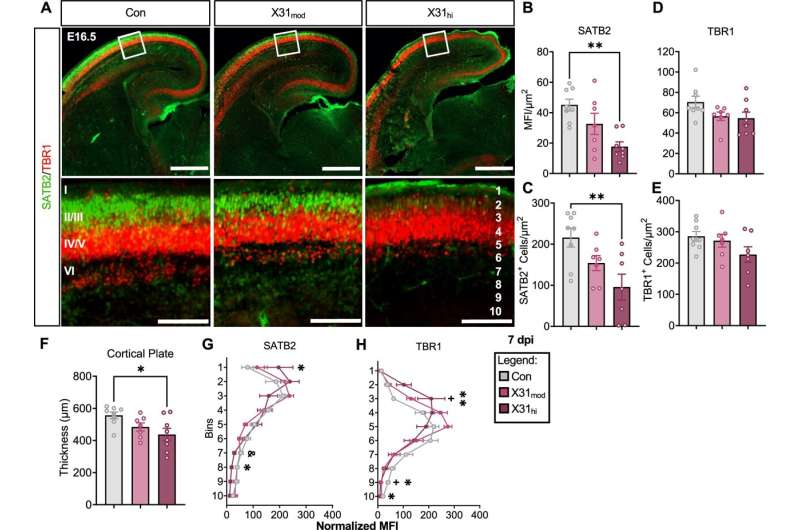This article has been reviewed according to Science X's editorial process and policies. Editors have highlighted the following attributes while ensuring the content's credibility:
fact-checked
peer-reviewed publication
trusted source
proofread
Fetal brain impacted when mom fights severe flu: New mouse study explains how

A bad case of the flu during pregnancy can increase the risk for fetal neurodevelopmental disorders such as schizophrenia and autism spectrum disorder. But it's not the virus itself doing the damage; it's the mother's immune response.
New University of Illinois Urbana-Champaign research using live mouse-adapted influenza virus improves upon previous mouse experiments to explain the process on a cellular and molecular level. It also indicates fetal brain changes are more likely once the severity of the mother's infection meets a specific threshold.
The work is published in the journal Molecular Psychiatry.
"Our data provide really compelling evidence for an infection severity threshold, which mimics what we see in humans. There are only a subset of maternal infections that are going to be severe enough to cause concerns like this. That said, pregnant people should definitely get the flu vaccine to reduce their risk," said senior study author Adrienne Antonson, assistant professor in the Department of Animal Sciences, part of the College of Agricultural, Consumer and Environmental Sciences at Illinois.
The study is one of only a handful to investigate maternal infection in mice using live influenza virus at doses that replicate seasonal flu outbreaks in humans. "That means our results are more relevant to human pathological infection," said lead study author Ashley Otero, a doctoral student in the Neuroscience Program at Illinois.
Antonson's team infected pregnant mice with live influenza A virus, rather than a viral mimic—an inert molecule that mimics viral behavior—used by most research groups in recent decades. The viral mimic elicits the innate immune response, broadly categorized as non-specific inflammation, that occurs within 24 to 48 hours of infection.
These studies have provided important clues about which inflammatory proteins are made by the mother and how they interact with the fetal brain. But Otero says viral mimics may prompt slightly different immune responses than the live virus in both mother and fetus, and they fail to capture what happens during the mother's adaptive immune response, which occurs later and helps an animal "remember" past infections.
To address these issues, the team subjected the mice to one of two doses of the virus—representing a moderate or severe infection—at the moment in gestation closest to the end of the first trimester in humans. Then, at two and seven days post-infection, they tracked how the infection progressed in the lungs and intestines of the mother, as well as how products from the mother's immune response interacted with the fetal brain. They also measured the physical properties of fetal brains, including the thickness of the cortex, which has been linked to neurodevelopmental disorders in humans.
Several important viral mimic studies in mice have implicated an immune protein called interleukin-17—primarily manufactured by T helper (Th)-17 cells in the mother's intestinal tract—in changes to the fetal brain and neurodevelopmental disorder-like behaviors after birth. But the live virus didn't activate that protein.
"At first, when I saw that interleukin-17 was not elevated in our moms from influenza infection, I was convinced we wouldn't see any changes in the developing fetal brain," Otero said. "But interestingly, we did see very similar responses in the developing neocortex, including dramatic reductions in the upper neuronal layers in fetuses from moms who had the higher-dose infection."
Otero further explains that postmortem human studies have documented smaller cortical structures in people with schizophrenia and autism spectrum disorder. "So, our results were really in line with what we see in human brains."
Antonson added, "We don't think it's ever going to be just one inflammatory molecule that's causing all these different things. But this is the first time this pathway has been thoroughly investigated and compared against models that, thus far, have demonstrated that interleukin-17 is really involved. That's why it's important to move beyond viral mimic models to the true live virus."
Having ruled out interleukin-17, at least at the time points they studied, the team tracked immune cells in the fetal brain. Microglia, which infiltrate the brain and interact with developing neurons, had signatures of increased inflammatory activity in fetuses from high-dose flu-infected mothers. Fetal border-associated macrophages (BAMs), which border the brain's surfaces and provide constant immune surveillance, were also more active and abundant.
Both cell types normally aid in healthy brain development, but Otero and Antonson think that when they're spurred into an overactive state, they could attack instead of support healthy developing neurons.
Viral mimic studies have also implicated overactive microglia in causing fetal brain deformities, but BAM activity is vastly understudied. Otero plans to follow up with more research to understand the role of BAMs in prenatal influenza infection.
Antonson emphasizes that maternal infection is only one of many risk factors for neurodevelopmental disorders.
"These disorders are caused by a multitude of elements, including environmental factors, genetics, pharmacological exposures, and more. We're focusing on just this in-utero period, but the early postnatal period is important, and adolescence is important. It's just one slice of a very complicated pie," explained Antonson.
More information: Ashley M. Otero et al, Influenza A virus during pregnancy disrupts maternal intestinal immunity and fetal cortical development in a dose- and time-dependent manner, Molecular Psychiatry (2024). DOI: 10.1038/s41380-024-02648-9



















